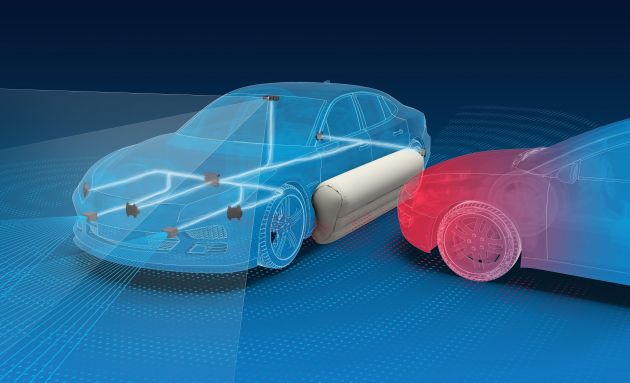Active and passive safety have typically been categorised separately, though automotive components maker ZF is likely to blur that line a little, with its development of external pre-crash airbags. These aim to create an external crumple zone which can be deployed immediately prior to a collision.
Restraint systems such as airbags are undergoing changes with regard to autonomous vehicles with new seating configurations, which presents a new set of challenges for airbag systems. “Occupant safety is paramount when developing new systems for automated and autonomous driving,” said ZF head of passive safety division Michael Büchsner.
The pre-crash airbag is designed to be deployed externally from the side of the vehicle, and helps to serve as an additional crumple zone in the event of a crash, and tests have shown it to reduce occupant injury severity by up to 40%, the company says.
The internal, ‘far-side’ airbag is also being developed to lower the risk of occupants colliding with interior structural components, and these technologies must be adapted to new seating positions that may be introduced in future autonomous cars, says ZF.
“The new test requirements of Euro NCAP, scheduled to be introduced by 2020, extend occupant safety requirements for the side facing away from the occupants in case of a side impact. In the future, the far-side airbag may be necessary in order to receive a 5-star crash safety rating,” said Norbert Kagerer, head of development at the passive safety systems division.
Elsewhere within the car’s cabin, supplementary restraint systems will have to adapt to differing layouts such as with movable seats. These may enable the car’s occupants to recline their seats or turn to face other directions, and restraint systems like seatbelts and airbags will increasingly be integrated into the seat itself in order to protect its occupants.
These adaptive, ‘dual contour’ airbags have been developed for this purpose, and are designed to adapt to the occupants’ varying positions and accommodate the freedom of movement afforded by autonomous cars.
Airbags in general are also subject to the lightweighting trend in the automotive industry, and ZF has developed a knee airbag that is the lightest in the industry, the company said. A housing made of fabric rather than metal aids in a weight reduction of up to 30% compared to conventional units, and volume production of these lightweight knee airbags are slated to begin in 2019.
No mention of airbags can overlook the steering wheel, and here the primary control of a car will also evolve with the development of increasingly autonomous vehicles. The classic round steering wheel shape will be joined by other shapes, and will also offer greater freedom of movement in conjunction with folding mechanisms. New developments of the driver airbag will follow suit, as they will likely also need to coexist with integrated displays, said ZF.
Related Cars for Sale on
Source: Read Full Article











